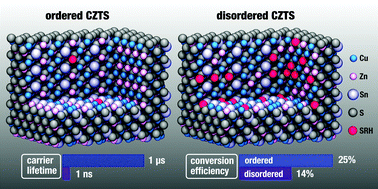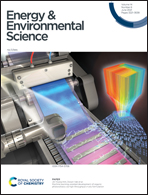Origin of the low conversion efficiency in Cu2ZnSnS4 kesterite solar cells: the actual role of cation disorder†
Abstract
The controversial role of cation disorder in the extraordinarily low open-circuit voltage (VOC) of the Cu2ZnSnS4 (CZTS) kesterite absorber is examined through a statistical treatment of disorder within the cluster-expansion method. It is demonstrated that the extensive Cu–Zn disorder alone cannot be responsible for the large Urbach tails observed in many CZTS solar cells. While the band gap is reduced as a result of the Gaussian tails formed near the valence-band edge due to Cu clustering, band-gap fluctuations contribute only marginally to the VOC deficit, thereby excluding Cu–Zn disorder as the primary source of the low efficiency of CZTS devices. On the other hand, the extensive disorder stabilizes the formation of SnZn antisite and its defect complexes, which as nonradiative recombination and minority carrier trapping centers dominate the VOC loss in CZTS. Our analysis indicates that current CZTS devices might have already approached the maximum conversion efficiency (14%) given the limited growth conditions and the remnant cation disorder even after postannealing. In view of the improved efficiency achieved with CZTS-derived kesterite absorbers, the methodology presented in this work offers an avenue to understanding and optimizing these emerging kesterite solar devices towards higher efficiency.



 Please wait while we load your content...
Please wait while we load your content...